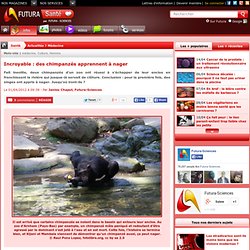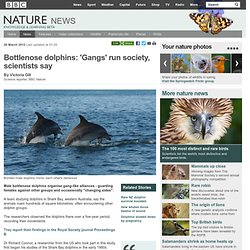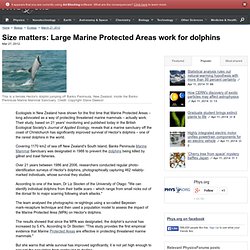

Incroyable : des chimpanzés apprennent à nager. Il est arrivé que certains chimpanzés se noient dans le bassin qui entoure leur enclos.

Au zoo d'Arnhem (Pays-Bas) par exemple, un chimpanzé mâle paniqué et redoutant d'être agressé par le dominant s'est jeté à l'eau et en est mort. Cette fois, l'histoire se termine bien, et Kijani et Mambala viennent de démontrer qu'un chimpanzé aussi, ça peut nager. © Raul Pons Lopez, fotolibre.org, cc by sa 2.5. Brain wiring a no-brainer? Scans reveal astonishingly simple 3D grid structure. The brain appears to be wired more like the checkerboard streets of New York City than the curvy lanes of Columbia, Md., suggests a new brain imaging study.

The most detailed images, to date, reveal a pervasive 3D grid structure with no diagonals, say scientists funded by the National Institutes of Health. "Far from being just a tangle of wires, the brain's connections turn out to be more like ribbon cables -- folding 2D sheets of parallel neuronal fibers that cross paths at right angles, like the warp and weft of a fabric," explained Van Wedeen, M.D., of Massachusetts General Hospital (MGH), A.A. Martinos Center for Biomedical Imaging and the Harvard Medical School. "This grid structure is continuous and consistent at all scales and across humans and other primate species. " Wedeen and colleagues report new evidence of the brain's elegant simplicity March 30, 2012 in the journal Science. "Before, we had just driving directions. BBC Nature - Bottlenose dolphins: 'Gangs' run society, scientists say.
28 March 2012Last updated at 01:33 By Victoria Gill Science reporter, BBC Nature Bonded male dolphins mimic each other's behaviour Male bottlenose dolphins organise gang-like alliances - guarding females against other groups and occasionally "changing sides".

A team studying dolphins in Shark Bay, western Australia, say the animals roam hundreds of square kilometres, often encountering other dolphin groups. The researchers observed the dolphins there over a five-year period, recording their movements. They report their findings in the Royal Society journal Proceedings B. Dr Richard Connor, a researcher from the US who took part in this study, first began his studies of the Shark Bay dolphins in the early 1980s. This latest study reveals that these highly intelligent marine mammals live in an "open society".
Will we ever… talk to dolphins? Here’s the fourth piece from my new BBC column “What’s that Flipper?

The treasure is over there?” So went a typical plotline for the popular TV series featuring the cute, bottlenosed dolphin who could communicate with his human guardians, and who – in the time-honoured fashion – used his animal powers to apprehend criminals. The idea that animals like Flipper can communicate with humans is not just the preserve of the small and big screen. History is littered with celebrity animals who have communicated with human scientists, with varying degrees of success. Dolphins hold a particular fascination; we are captivated by their intelligence and beauty, and swimming with dolphins features regularly on lists of things to do before you die.
One-way chat “Talk” is tricky to define. The idea of talking to dolphins has a long and chequered history. Lilly was right about dolphin intelligence, but not dolphin language. Little less conversation Wild dolphin communication is hard to study. Size matters: Large Marine Protected Areas work for dolphins. Ecologists in New Zealand have shown for the first time that Marine Protected Areas – long advocated as a way of protecting threatened marine mammals – actually work.

Their study, based on 21 years' monitoring and published today in the British Ecological Society's Journal of Applied Ecology, reveals that a marine sanctuary off the coast of Christchurch has significantly improved survival of Hector's dolphins – one of the rarest dolphins in the world. Covering 1170 km2 of sea off New Zealand's South Island, Banks Peninsula Marine Mammal Sanctuary was designated in 1988 to prevent the dolphins being killed by gillnet and trawl fisheries. Over 21 years between 1986 and 2006, researchers conducted regular photo-identification surveys of Hector's dolphins, photographically capturing 462 reliably-marked individuals, whose survival they studied. The results showed that since the MPA was designated, the dolphin's survival has increased by 5.4%.
Has modern science become dysfunctional? The recent explosion in the number of retractions in scientific journals is just the tip of the iceberg and a symptom of a greater dysfunction that has been evolving the world of biomedical research say the editors-in-chief of two prominent journals in a presentation before a committee of the National Academy of Sciences (NAS) today.

"Incentives have evolved over the decades to encourage some behaviors that are detrimental to good science," says Ferric Fang, editor-in-chief of the journal Infection and Immunity, a publication of the American Society for Microbiology (ASM), who is speaking today at the meeting of the Committee of Science, Technology, and Law of the NAS along with Arturo Casadevall, editor-in -chief of mBio, the ASM's online, open-access journal. James Cameron Successfully Reaches "the Deepest Spot on Earth" (UPDATED) Fosse des Mariannes : James Cameron seul à 10.898 mètres de profondeur. Le sous-marin Deepsea Challenger pèse 11,8 tonnes (contre 150 tonnes pour le Trieste).

Il est alimenté par des milliers de petites batteries au lithium-ion similaires à celles utilisées dans l'aéromodélisme, mais de plus grande taille. Plus de 180 systèmes électroniques sont actifs durant la navigation. © Mark Thiessen, National Geographic Fosse des Mariannes : James Cameron seul à 10.898 mètres de profondeur - 3 Photos Le point le plus profond de la Planète, Challenger Deep, se trouverait à 10.994 mètres de profondeur sous la surface de l’océan Pacifique, à proximité des îles Mariannes. La pression y est considérable : plus de 1.100 atmosphères. La première exploration de Challenger Deep eut lieu le 23 janvier 1960. James Cameron Breaks Solo Dive Record.